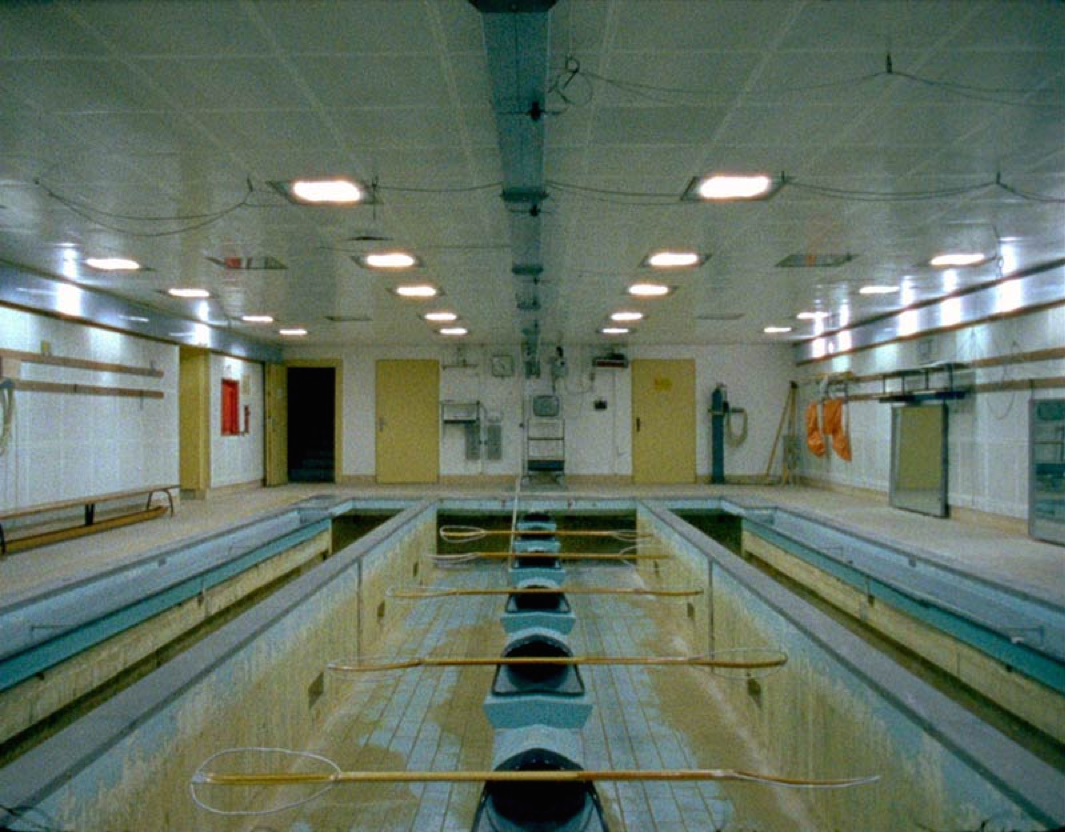If a revolution is a release of pressure, what becomes of the force following its release? Andreas Bunte, a recent SFU Audain Visual Artist in Residence, attempts to address this question by looking at two spaces of differential pressure in the former German Democratic Republic (GDR).
Bunte’s two films, presented as a double film installation at the Or Gallery, use an athletic training facility, Underdruck (Low-Pressure), and a synthetic diamond manufacturer, Künstliche Diamanten (Synthetic Diamonds), as respective subjects to document the technological achievements of the GDR.
Bunte primarily works in the medium of 16mm celluloid film. The grainy, anachronistic look of 16mm is congruous to the subject matter being depicted. After the fall of the Berlin Wall, each of these spaces was affected. The synthetic diamond institute lost its state funding. It then had to relocate and become a private enterprise. The training facility, designed to simulate the low pressure of high altitudes, fell into disuse due to the cost of renting the space. Because of the way it was built, it was also too costly to destroy, ostensibly becoming a monument to the era in which it was created.
Both spaces feel lost in time due to the prevalence of the dated, analogue technologies that they contain. Through these short films, Bunte affords the viewer a privileged look at processes and spaces rarely seen, while also framing the banality inherent in each.
A diamond is created over billions of years in high-pressure areas kilometres beneath the earth. In Künstliche Diamanten, we witness the transformation of graphite into a diamond over the course of several minutes. The final product is cut out of its casing using a tool that looks like a butter knife.
In Underdruck, Bunte takes us into what looks like a Cold War-era spy bunker, straight out of a Roger Moore James Bond film, but then reveals the banality within: the faded plastics in the offices, the humming frequencies of the rooms, and the blinking fluorescent lights.
Due to its isolation, the GDR had to rely on synthetic processes to maintain its independence. Whether it was through the production of plastics, synthetic fibres, or synthetic diamonds, a GDR state-owned economy had to rely on technological innovation to keep up with its Western counterparts, let alone stay afloat. The two subjects of Bunte’s films are a testament to the stubborn ingenuity of the GDR, which reduced the need for its people to bring in outside goods or travel outside the country — not that the GDR populace ever had much choice.
A couple blocks away from the Or Gallery, Andreas Bunte also has an exhibition at Republic Gallery. This exhibition, Lettuce Partially Emerging from a Shopping Bag, features another 16mm film, titled Suspended Durations. The film documents actors performing everyday tasks, such as unpacking a bag of groceries, using a swipe card machine, and untangling a set of earbuds. In each film there is a grid background placed in the frame of the action, and as each action is performed, sometimes in multiple takes, the sound of the 16mm camera whirs in the background, along with the artist’s voice calling out directions over sections of black in between shots.
The placement of the grid within the frame of action, along with the uncut sound and occasional flash frames, give the sense that we are watching a scientific motion study — normally conducted to improve work practices by maximizing the efficiency of the body’s movement — while also referring to what is taking place behind-the-scenes. By juxtaposing the mundane activities in a makeshift setting of empirical observation, Bunte questions the motives behind these motion studies, while also creating absurd scenarios of everyday life.
Two Films About Pressure is at the Or Gallery until November 22. Visit orgallery.org for more information. Lettuce Partially Emerging From a Shopping Bag is at Republic Gallery until November 8. Visit republicgallery.com for more information.

